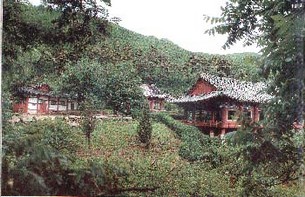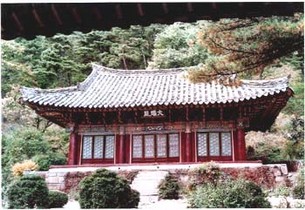Ryangchon Temple
The Ryangchon Temple, located at the foot of the picturesque Mt. Panryong in Rakchon-ri, Kowon County, South Hamgyong Province, is a site of the national treasure.

The Great Leader Comrade Kim Jong Il with a deep concern for the preservation of the national cultural heritages permeated with the wisdom and talents of our ancestors called at the temple on June 1, Juche 91 (2002).
This time-honored temple has not been widely known to the outside world.
That day, the Great General personally looked round the Taeung Hall and the Manse Pavilion. Highly evaluating the national cultural heritage, especially the ceiling paintings in the Taeung Hall, he meticulously said that they should be preserved, kept well and widely opened to the public.
The Ryangchon Temple, at present, consists of three buildings, Taeung Hall, Manse Pavilion and Muryangsu Hall, which were built in 753. The Taeung Hall was rebuilt in 1636 and Manse Pavilion in 1729.
The buildings are notably cosy and magnificent, and every structural element has a trace of delicate workmanship.
The Taeung Hall, a main building, is built in a bracket type with 5 brackets outside and 7 inside and the brackets differ in shape according to the position.

The joints of every structural element are harmoniously sculptured with a dragon, a phoenix and a lotus.
Manse Pavilion is the biggest of all the pavilions in the temples of our country.
The structure is 4 Ikgong bracket of exterior cross beam type on the armful wooden posts erected on the stone pillars. The delicate Hwaban and Choyop decorations are really fascinating.
The most notable in the temple is the colorings of the buildings and the detached paintings of the Taeung Hall.
A court dance painting on the inclined ceiling is given against the colorful and graceful silk-design coloring, details of monks’lives on the walls between the brackets, Munsu and Pohyon Bodhisattvas, a blue dragon and a yellow dragon on the tie beam.
The court dance painting on the inclined ceiling is spectacular.
The court dance painting shows that more than 20 men and women dance, blowing and beating instruments like a drum, a cymbal (a Korean gong), a Saenap (a Korean brass wind instrument), a flute, a Kayagum (Koran string instrument) and a Janggo (a long Korean drum that tapers in the middle) around two women who hold “Eternal Youth” peaches on a tray.
The folds of the dresses made according to their action and the detailed expressions on their faces are well depicted by a tr aditional way of single brush stroking.
The Ryangchon Temple still preserves its original appearance as it was thanks to the policies of the cultural preservation of the Workers’ Party of Korea.
The excellent architectural and artistic skill of our ancestors will add to enhancing the national honor and pride of our people.

Photographed by Chae Tal Song, Ri In Chol, Ryu Tok In, Han Ui Song
Written by Ri Ki Ung, Pyon Ryong Mun, Kim Su Yong
Edited by Kim Yong Ok, Kim Myong Jo
Translated by Kim Sung Il
PYONGYANG, KOREA JUCHE 91 (2002)

